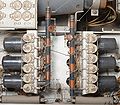514
The Tektronix 514 is a monolithic general-purpose oscilloscope introduced in 1949 or 1950.
It was designed by Tektronix engineers Bob Davis and Dick Rhiger.
Using a three-section distributed distributed amplifier, it provides frequency response from DC to 10MHz. Prior to the 514, customers had to choose between an instrument with 10 MHz bandwidth (the 511) or an instrument with DC response (the 512).
The 514 provides DC response and 10 MHz bandwidth. It weighs 60 pounds (27 kg) and consumes 360 W. The 514 uses a 5CPA CRT with a total accelerating voltage of 3000 V (-1.5 kV on the CRT cathode and +1.5 kV on the CRT anode) . The standard phosphor for a 514 was P1. The deflection sensitivity of the CRT is approximately 27 V/cm vertical and 32 V/cm horizontal.
The power supply is regulated based on a -140 V reference produced by a OD3 gas regulator tube. The +225 V supply uses three 5V4G rectifier tubes in parallel.
Throughout its production run, a 'D' variant was available (514D, with the 'D' being stamped in by hand) which has a 24-section 250 ns lumped L-C delay line. There was also an 'A' version (514-A & 514-AD respectively), which appears to have been available in 1954. (How does the 514AD differ from the 514D?)
It has no thermal cutoff.
Key Specifications
| Frequency response | DC to 10 MHz |
|---|---|
| Input impedance | 1 MΩ // 30 pF |
| Vertical deflection | 100 V/cm down to 300 mV/cm (DC) / 30 mV/cm (AC), 1 - 3 - 10 sequence |
| Weight | 62 pounds (28.1 kg) |
| Power consumption | 375 W |
Pictures
-
Front
-
Distributed vertical amp
-
Delay line trimmer caps
-
Bottom view
-
Power Supply
-
Upper Deck, rear
-
Upper Deck, front
-
Lower Deck, front
-
Lower Deck, rear
-
Fan Motor
-
Line Socket
-
Vertical amp schematic












